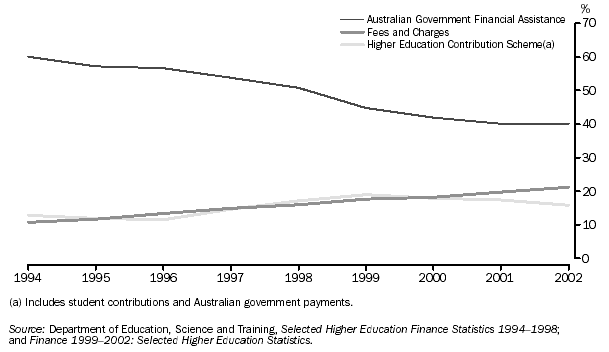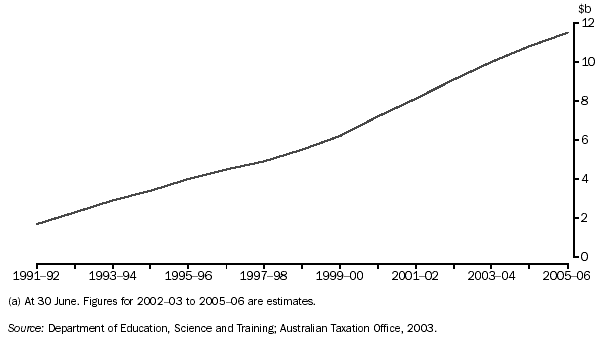|
|
Expenditure: Paying for University Education
In 2002, two-thirds (67%) of higher education students were required to pay HECS, and most of them (79%) had chosen to defer their payment.
Financing of Australian higher education has undergone dramatic change since the early 1970s. Although the Australian Government provided regular funding for universities from the late 1950s, in 1974 it assumed full responsibility for funding higher education - abolishing tuition fees with the intention of making university accessible to all Australians who had the ability and who wished to participate in higher education.(SEE ENDNOTE 1)
Since the late 1980s, there has been a move towards greater private contributions, particularly student fees. In 1989, the Australian Government introduced the Higher Education Contribution Scheme (HECS) which included a loans scheme to help students finance their contributions. This enabled universities to remain accessible to students by delaying their payments until they could afford to pay off their loans. In 2002, the Australian Government introduced a scheme similar to HECS for postgraduate students - the Postgraduate Education Loan Scheme (PELS).
Funding for higher education comes from various sources. This article examines the three main sources - Australian Government funding, student fees and charges, and HECS. While the proportion of total revenue raised through HECS is relatively small, HECS payments are a significant component of students' university costs, with many students carrying a HECS debt for several years after leaving university. This article also focuses on characteristics of university students based on their HECS liability status, and the level of accumulated HECS debt.
SELECTED SOURCES OF HIGHER EDUCATION FUNDING

HIGHER EDUCATION
Data in this article are from the Department of Education, Science and Training Higher Education Statistics Collection.
Data relating to the Higher Education Contribution Scheme are reported in terms of an equivalent full-time student unit (EFTSU). An EFTSU value represents the student load for a unit of study or part of a unit of study or set thereof, expressed as a proportion of the workload for a 'standard student load'. (SEE ENDNOTE 2)
The Higher Education Contribution Scheme (HECS) requires most students to contribute towards the cost of their higher education. A student's liability status is calculated on a semester by semester basis from his or her student load and the annual course contributions.
HECS-liable students are those who are required to contribute to HECS either through deferred repayments or up-front payments.
HECS-exempt students do not contribute to HECS but pay up-front fees or have a scholarship.
Overseas students are those students coming from outside Australia to study at Australian institutions. |
 |
SOURCES OF HIGHER EDUCATION FUNDING AS PROPORTION OF TOTAL REVENUE |
|
 | 1997 | 2002 |
 |  |  |
| Source | % | % |
|
| Australian Government | 53.8 | 40.1 |
| State and Territory Governments | 1.1 | 4.0 |
| HECS(a) | 14.7 | 15.8 |
| Fees and charges | 14.9 | 21.2 |
| Fee paying domestic students | 1.5 | 2.8 |
| Fee paying overseas students | 7.6 | 12.5 |
| Other fees and charges | 5.8 | 5.9 |
| Other income(b) | 15.4 | 18.9 |
 |  |  |
| Total | 100.0 | 100.0 |
 |
 | $b | $b |
|
| Total revenue | 8.2 | 11.6 |
|
| (a) Includes student contributions and Australian Government payments. |
| (b) Includes PELS; superannuation; investment income; royalties, trademarks and licenses; and consultancy and contract research. |
 |
| Source: Department of Education, Science and Training, Selected Higher Education Finance Statistics, 1997; and Finance 2002: Selected Higher Education Statistics. |
 |
SOURCES OF HIGHER EDUCATION FUNDING
In 2002, the total operating revenue for Australian higher education institutions was $11.6 billion, an increase from $8.2 billion in 1997. In 2002, the three largest sources of higher education funding were Australian Government contributions ($4.7 billion), fees and charges ($2.5 billion), and HECS($1.8 billion).
HIGHER EDUCATION CONTRIBUTION SCHEME
The Higher Education Contribution Scheme (HECS) was introduced in 1989. Under HECS, students choose to pay their contribution up-front or defer their payment, with the Australian Government providing a 25% discount to eligible students who pay up-front. Students who choose to defer their payment take out a loan with the government and agree to repay that loan when their income reaches the minimum threshold for compulsory repayment.(SEE ENDNOTE 3)
Higher education students are either HECS-liable and required to contribute towards HECS through up-front or deferred payments, or HECS-exempt and not required to contribute to HECS. In general, undergraduate students are HECS-liable while postgraduate students are HECS-exempt and are therefore required to pay up-front fees unless they have a scholarship.
A feature of HECS is that payment arrangements are based on the individual’s capacity to pay. This arrangement means that students are not prevented from participating in higher education by an inability to pay up-front. Students are not required to make payments until their personal income in a financial year exceeds the minimum threshold, which was $24,365 for the 2002-2003 financial year. The level of payment required above this threshold depends on the person’s income.(SEE ENDNOTE 4) |
Funding provided by the Australian Government to higher education increased from $4.4 billion in 1997 to $4.7 billion in 2002. As a proportion of overall funding, this represented a decrease from 54% in 1997 to 40% in 2002.
The contribution of student fees and charges (other than HECS) to higher education funding more than doubled between 1997 and 2002, from $1.2 billion to $2.5 billion. This represented an increase in the proportion of overall funding from 15% in 1997 to 21% in 2002. This increase coincided with a large increase in the total number of overseas students (from 63,000 in 1997 to 185,000 in 2002) as well as the introduction of full-fee-paying places for domestic undergraduate students in 1998.
In 2002, $1.8 billion was raised through HECS, representing 16% of all higher education funding. This compares with 15% raised through HECS in 1997.
 |
HECS LIABILITY STATUS OF HIGHER EDUCATION STUDENTS |
|
 | 1992 | 1997 | 2002 |
 |
| HECS liability status | % | % | % |
|
| HECS-liable | 81.7 | 78.7 | 67.1 |
| HECS-exempt | 18.3 | 21.3 | 32.9 |
| Overseas fee-paying | 4.8 | 10.9 | 20.0 |
| Domestic fee-paying | 2.2 | 3.2 | 4.8 |
| PELS-liability deferred(a) | . . | . . | 1.8 |
| Other HECS-exempt(b) | 11.3 | 7.2 | 6.4 |
 |  |  |  |
| Total | 100.0 | 100.0 | 100.0 |
|
| (a) PELS introduced in 2002. |  |  |  |
| (b) Includes overseas foreign aid sponsored students; Australian Postgraduate Awards; enabling courses; and non-award courses. |
 |
| Source: Department of Education, Science and Training, Selected Higher Education Student Statistics, 1992 and 1997 and Students 2002: Selected Higher Education Statistics. |
 |
STUDENTS AND HECS
Since the introduction of HECS in 1989, the majority of higher education students have entered university with a commitment to make a substantial contribution to the cost of their education via HECS. In 1989, around 372,000 students were HECS-liable, increasing to 420,000 in 2002. There was a decrease over this period in the proportion of students who were HECS-liable, from 86% to 67%. The decrease in the proportion of HECS-liable students reflects increasing numbers of overseas students and domestic fee-paying students since the late 1990s - both of these groups are largely HECS-exempt.
 |
STUDENTS' LIABILITY STATUS BY LEVEL OF EDUCATION - 2002 |
|
 | HECS-liable | HECS-exempt |
| Level of education | % | % |
|
| Postgraduate Degree | 8.0 | 92.0 |
| Graduate Diploma and Graduate Certificate | 27.6 | 72.4 |
| Bachelor Degree | 81.3 | 18.7 |
| Advanced Diploma and Diploma | 79.0 | 21.0 |
| Other | 10.8 | 89.2 |
| Total | 67.1 | 32.9 |
|
| Source: Department of Education, Science and Training, Students 2002: Selected Higher Education Statistics. |
 |
Most undergraduate students use the HECS system, either by paying up-front or deferring their payments. In 2002, 81% of students undertaking Bachelor Degrees and 79% of those undertaking Advanced Diplomas or Diplomas were HECS-liable.
...PAYING HECS
Since the introduction of HECS, the amount charged and the rate of repayment through the tax system have varied. In 1989, all students were charged a flat rate irrespective of their course of study. In 1997, a three-tiered system of charges was introduced to reflect the differing cost structure of various courses and the differing potential earning capacity of graduates.(SEE ENDNOTE 4)
HECS-liable students have the option of paying their HECS fees up-front to obtain a discount (25% in 2004), or delaying payments until they have attained a certain level of income. At this time, a proportion of an individual's salary is paid towards their HECS debt through the tax system. Of the 420,000 HECS-liable students in 2002, 79% deferred their payment while 21% paid up-front with a discount. Each year, the Australian Government contributes the difference between repayments received and the total HECS payments required to be made to the sector. In 2002, 17% of funding provided by HECS came from students' HECS contributions. The remaining 83% was paid by the government through loans to students deferring their payments, ultimately paid back through the tax system.
...HECS DEBT
From the introduction of the scheme in 1989, through to June 2003, over 1.7 million students have taken out HECS loans totalling around $13 billion. Of these, more than 600,000 have repaid their loans in full.(SEE ENDNOTE 5) During this period, Australia's accumulated HECS debt has increased steadily to more than $9 billion in 2003, and is estimated to reach $12 billion by 2006.
AUSTRALIA'S ACCUMULATED HECS DEBT(a)

In 2003, the average amount owing on individual HECS loans was $8,500 overall. However, there was some variation across the states and territories with the average HECS debt ranging from $6,900 in the Northern Territory to $9,000 in Australian Capital Territory.(SEE ENDNOTE 5) Of the 1.2 million people with a HECS loan in 2003, around two-thirds owed $10,000 and or less, while 6% owed more than $20,000.(SEE ENDNOTE 5)
...HECS-EXEMPT STUDENTS
Over the decade to 2002, the number of HECS-exempt students almost doubled from 104,000 in 1992 to 206,000 in 2002. The increase in the number of HECS-exempt students over the decade to 2002 may be largely due to the increase in the number of overseas fee-paying students (5% of all students in 1992 compared with 20% in 2002). The majority of overseas students are full-fee-paying or are recipients of aid scholarships. In 2002, the majority (61%) of HECS-exempt students were overseas fee-paying students, more than twice the proportion of overseas fee-paying students in the HECS-exempt category in 1992 (26%).
As well as the increase in the number of overseas students over the decade to 2002, there was also an increase in the number of domestic fee-paying students. In 1992, only 2% of all students were domestic fee-paying students. This increased to 5% (or 30,000 students) in 2002. Full-fee-paying places for undergraduate courses were introduced in 1998. In 2002, 22% of domestic fee-paying students were undergraduates, increasing from 4% in 1998.
ENDNOTES
1 Department of Education, Science and Training 2001, The National Report on Higher Education in Australia, DEST, Canberra.
2 Department of Education, Science and Training 2004, HECS, loans and fees manual, 2004, DEST, Canberra.
3 Department of Education, Science and Training 2002, DEST Annual Report 2001-2002, DEST, Canberra.
4 Department of Education, Science and Training 2003, Higher Education Report for the 2003 to 2005 Triennium, DEST, Canberra.
5 Australian Taxation Office 2003.
|
 Print Page
Print Page
 Print All
Print All